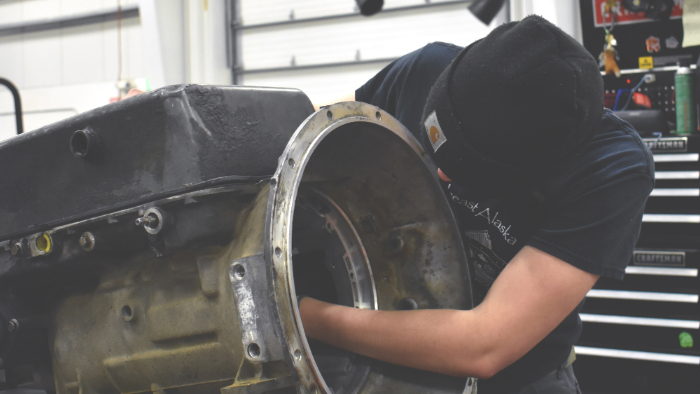Diesel/Heavy Equipment Technologies

Generally, over half the investment of a mining, construction, highway transportation, or logging business is in its equipment. Preventive maintenance is a priority to the success of the business.
In AVTEC’s Diesel/Heavy Equipment Technologies program, students learn how to service, maintain, and repair equipment ranging from semi-trucks to bulldozers. As most equipment is powered by diesel engines, students will disassemble, measure, and reassemble engines to factory specifications. Construction equipment such as dump trucks, road graders, front-end loaders, backhoes, bulldozers, and large transport trucks are utilized by instructors to help develop students’ mechanical skills.
The technological changes in the past few years have led to the use of laptop and dedicated scan tools for diagnosis of electronically controlled engines and systems. Because of the complexity of this equipment, students should have mechanical aptitude, strong reading and mathematics skills, work ethic, and the desire to succeed.
The Diesel/Heavy Equipment Technologies program offers a blend of classroom instruction, lab, and live work practice. This program is fast-paced and challenging. The small class sizes at AVTEC provide students with the opportunity to experience extensive hands-on training.
The Diesel/Heavy Equipment Technologies program prepares students for entry-level employment and for apprenticeships in the construction and maintenance trades.
Program offered in: January, August
Training Times: 8:30 am to 3:30 pm, Monday through Friday
Clock Hours: 1080
Requirements
Information Technology Requirements
Demonstrate understanding using the following electronic equipment and functions:
- Laptop computers
- Electronic tablets (iPads are used in the program – provided as part of the books and supplies)
- Have a thorough understanding of computer graphic interfaces, specifically Windows
- Operate and interpret diagnostic equipment, including scan tools utilizing OEM software
Employment Requirements
- Most positions require a clean driving record with the ability to earn a valid Alaska driver’s license
- Most positions require the ability to earn a Commercial Driver’s License (CDL) - (No CDL disqualifiers)
- Demonstrate the ability to show up on time, rested and dressed for work
- Safety-conscious and situationally aware of surroundings
- Understand and willingly enforce industry safety standards
- May need to be able to obtain a Transportation Worker Identification Credential (TWIC®) card
Program Specific Requirements
- Students must arrive on time and attend training daily (Mon-Fri 8:30 am to 3:30 pm)
- Ability to succeed in a demanding environment with rigorous academic and technical training
- Should be comfortable with constant physical activity
- Ability to stand, walk, sit, lift, carry, push, pull, twist, turn, bend, squat, climb, kneel, crouch, crawl and reach continuously
- Required to wear safety goggles/glasses in shop areas
- Proper prescription safety glasses are recommended for students with prescription lenses
- Will supply properly fitting work clothes and steel toe or reinforced toe work boots
- Will be prepared and dressed appropriately for working in inclement winter weather
- The following are minimum level of physical requirements expected to be performed:
- Lift 75 pounds
- Carry 50 pounds
- Push 100 pounds
- Pull 50 pounds
Industry Certifications
- OSHA 10
- First Aid and CPR
- Receive training to obtain EPA 609 certification for handling of refrigerants
Graduation Achievement Levels
Level 1- Diesel/Heavy Equipment, Oiler
Level 2- Diesel/Heavy Equipment, Assistant
Level 3- Diesel/Heavy Equipment, Entry-Level
